Abstract
The activity of microsomal 3-hydroxy-3-methylglutaryl coenzyme A reductase (HMG-CoA reductase) [mevalonate:NADP+ oxidoreductase (CoA-acylating); EC 1.1.1.34] was inhibited by ATP+Mg2+. Inactivation of HMG-CoA reductase by ATP+Mg2+ was dependent on time, temperature, and ATP concentration. Incubation of microsomal HMG-CoA reductase with [gamma-32P]ATP+Mg2+ was associated with a reciprocal increase in [32P]protein-bound radioactivity and a decrease in enzymatic activity. Incubation of 32P-labeled microsomal HMG-CoA reductase with a partially purified cytosolic phosphatase resulted in a time-dependent reciprocal release of [32P]protein-bound radioactivity and reactivation of enzyme activity. Phosphorylation of HMG-CoA reductase was confirmed by immunoprecipitation of partially purified [gamma-32P]-ATP+Mg2+-inactivated microsomal HMG-CoA reductase with a reductase-specific antiserum. Sodium dodecyl sulfate electrophoresis of the [gamma-32P]immunoprecipitate revealed that the 32P radioactivity was located in the electrophoretic position of HMG-CoA reductase. These results established that the reversible inactivation of HMG-CoA reductase by ATP+Mg2+ was due to covalent modification of the enzyme by a phosphorylation-dephosphorylation reaction sequence. The existence of HMG-CoA reductase in interconvertible active and inactive forms provides a mechanism for the rapid short-term regulation of the pathway for cholesterol biosynthesis.
Full text
PDF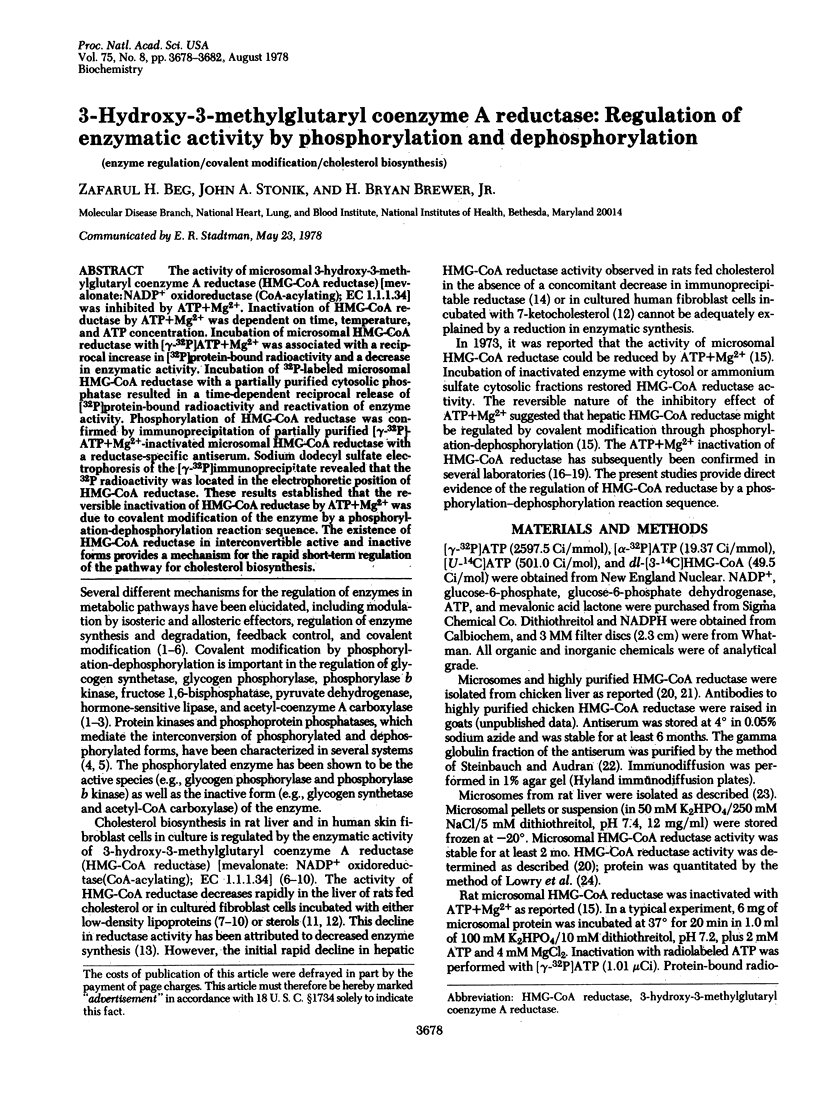
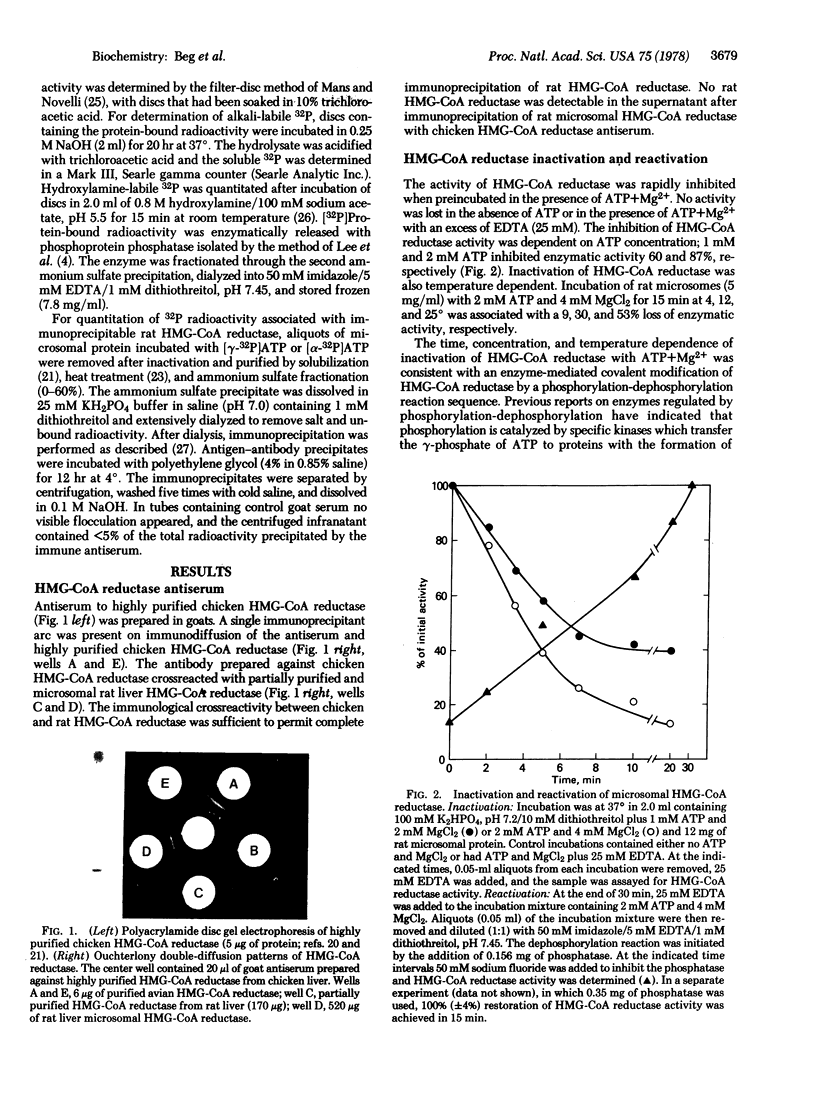
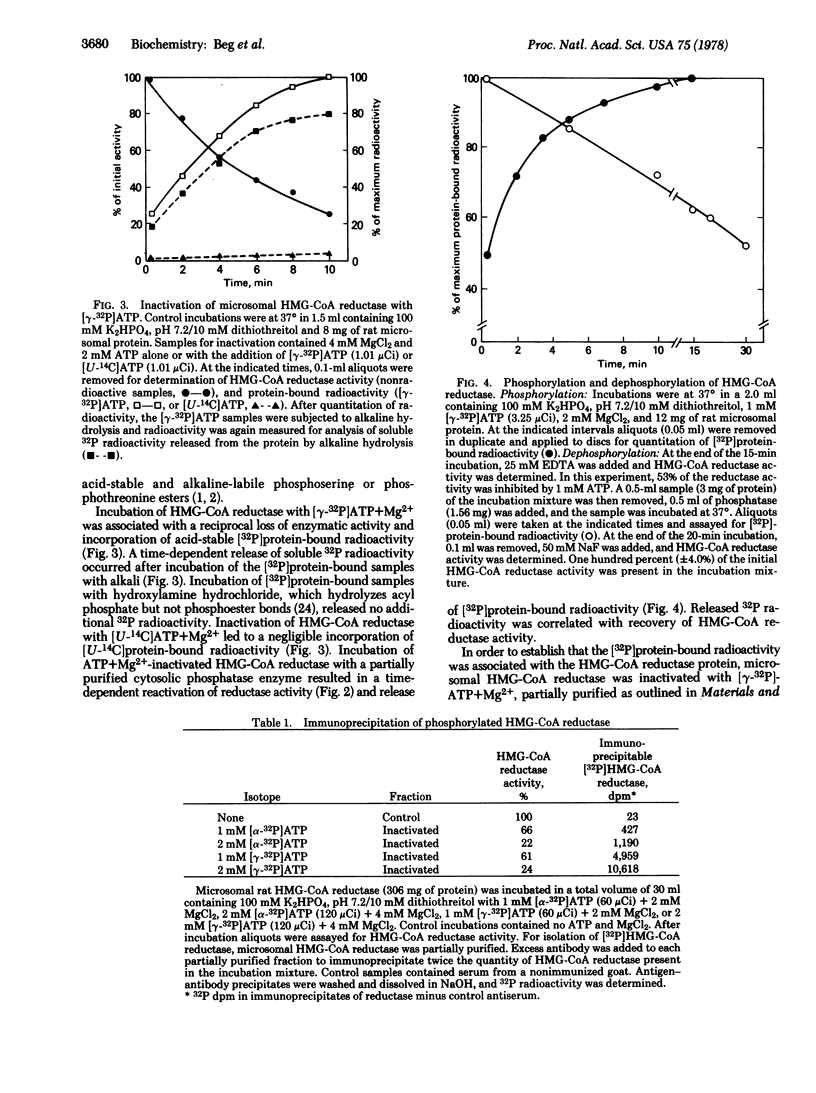
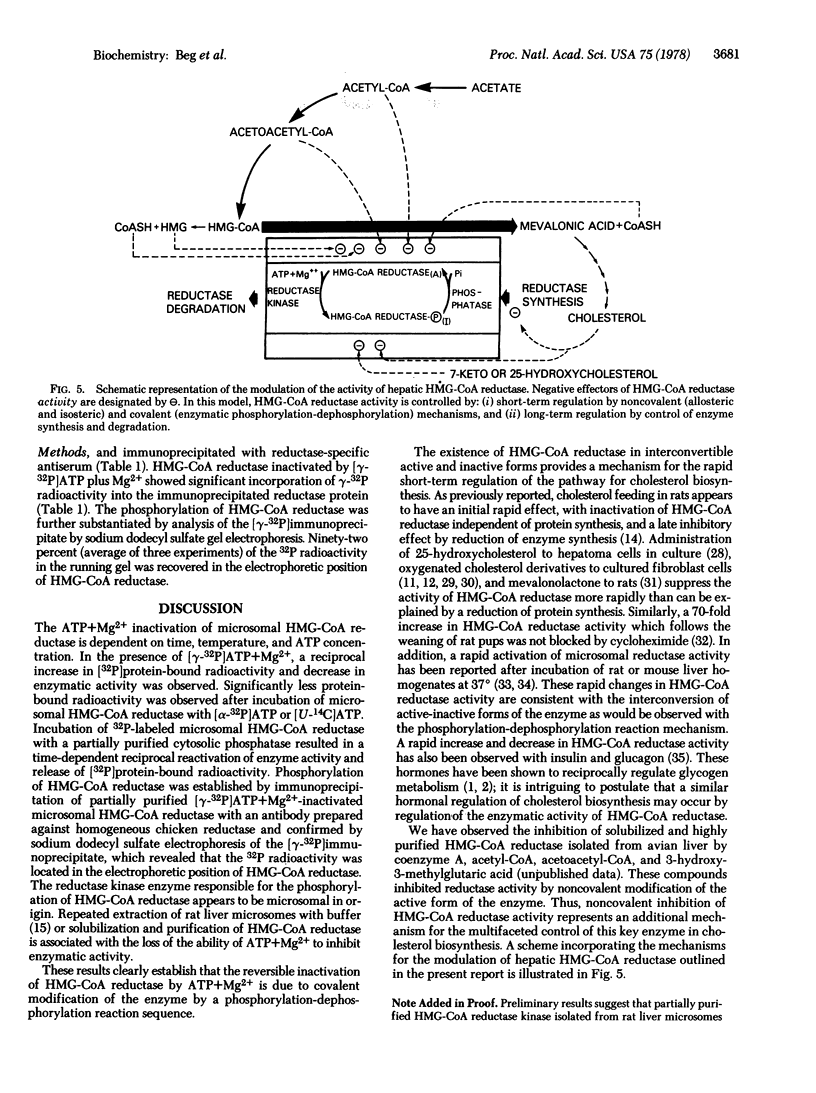
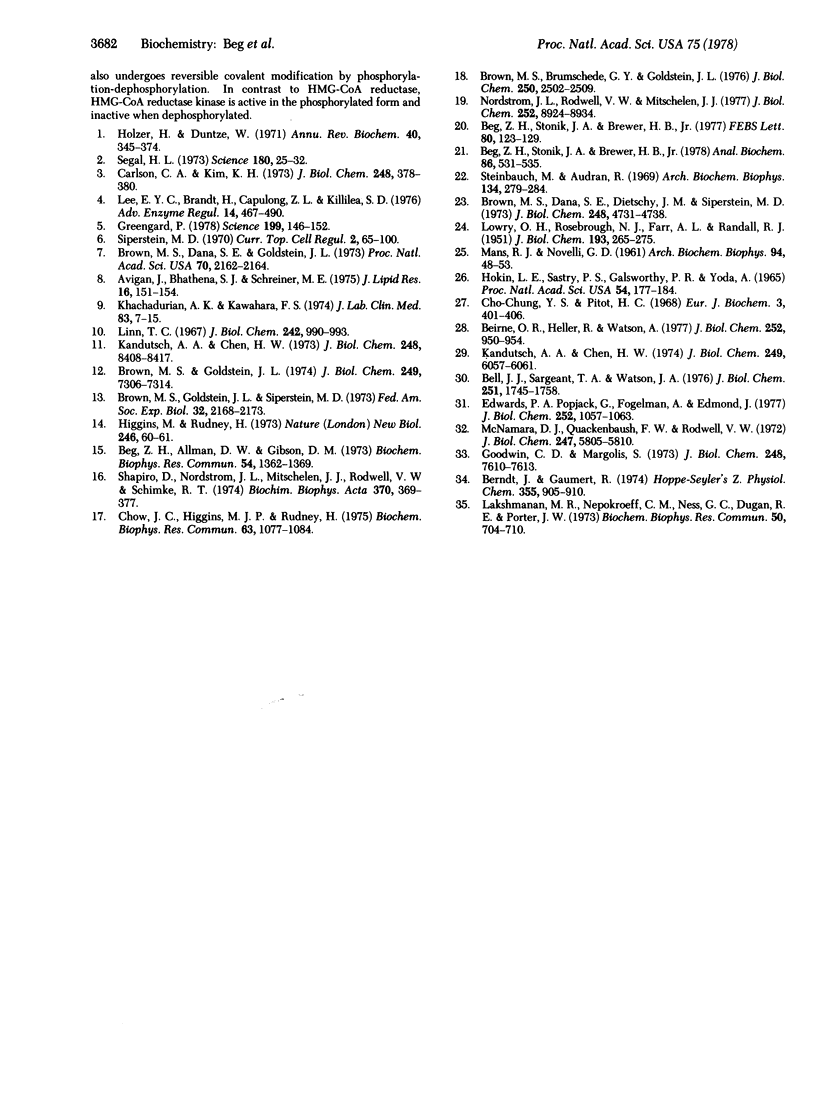
Images in this article
Selected References
These references are in PubMed. This may not be the complete list of references from this article.
- Avigan J., Bhathena S. J., Schreiner M. E. Control of sterol synthesis and of hydroxymethylglutaryl CoA reductase in skin fibroblasts grown from patients with homozygous type II hyperlipoproteinemia. J Lipid Res. 1975 Mar;16(2):151–154. [PubMed] [Google Scholar]
- Beg Z. H., Allmann D. W., Gibson D. M. Modulation of 3-hydroxy-3-methylglutaryl coenzyme A reductase activity with cAMP and wth protein fractions of rat liver cytosol. Biochem Biophys Res Commun. 1973 Oct 15;54(4):1362–1369. doi: 10.1016/0006-291x(73)91137-6. [DOI] [PubMed] [Google Scholar]
- Beg Z. H., Stonik J. A., Brewer H. B., Jr Purification and characterization of 3-hydroxy-3-methylglutaryl coenzyme A reductase from chicken liver. FEBS Lett. 1977 Aug 1;80(1):123–129. doi: 10.1016/0014-5793(77)80421-3. [DOI] [PubMed] [Google Scholar]
- Beg Z. H., Stonik J. A., Brewer H. B., Jr Solubilization of 3-hydroxy-3-methylglutaryl coenzyme A reductase from rat and chicken liver microsomes. Anal Biochem. 1978 Jun 1;86(2):531–535. doi: 10.1016/0003-2697(78)90779-0. [DOI] [PubMed] [Google Scholar]
- Beirne O. R., Heller R., Watson J. A. Regulation of 3-hydroxy-3-methylglutaryl coenzyme a reductase in minimal deviation hepatoma 7288C. Immunological measurements in hepatoma tissue culture cells. J Biol Chem. 1977 Feb 10;252(3):950–954. [PubMed] [Google Scholar]
- Bell J. J., Sargeant T. E., Watson J. A. Inhibition of 3-hydroxy-3-methylglutaryl coenzyme A reductase activity in hepatoma tissue culture cells by pure cholesterol and several cholesterol derivatives. Evidence supporting two distinct mechanisms.20l. J Biol Chem. 1976 Mar 25;251(6):1745–1758. [PubMed] [Google Scholar]
- Berndt J., Gaumert R. Evidence for an activating-inactivating system of 3-hydroxy-3-methylglutaryl-CoA reductase in mouse liver. Hoppe Seylers Z Physiol Chem. 1974 Jul;355(7):905–910. [PubMed] [Google Scholar]
- Brown M. S., Brunschede G. Y., Goldstein J. L. Inactivation of 3-hydroxy-3-methylglutaryl coenzyme A reductase in vitro. An adenine nucleotide-dependent reaction catalyzed by a factor in human fibroblasts. J Biol Chem. 1975 Apr 10;250(7):2502–2509. [PubMed] [Google Scholar]
- Brown M. S., Dana S. E., Dietschy J. M., Siperstein M. D. 3-Hydroxy-3-methylglutaryl coenzyme A reductase. Solubilization and purification of a cold-sensitive microsomal enzyme. J Biol Chem. 1973 Jul 10;248(13):4731–4738. [PubMed] [Google Scholar]
- Brown M. S., Dana S. E., Goldstein J. L. Regulation of 3-hydroxy-3-methylglutaryl coenzyme A reductase activity in human fibroblasts by lipoproteins. Proc Natl Acad Sci U S A. 1973 Jul;70(7):2162–2166. doi: 10.1073/pnas.70.7.2162. [DOI] [PMC free article] [PubMed] [Google Scholar]
- Brown M. S., Goldstein J. L., Siperstein M. D. Regulation of cholesterol synthesis in normal and malignant tissue. Fed Proc. 1973 Dec;32(12):2168–2173. [PubMed] [Google Scholar]
- Brown M. S., Goldstein J. L. Suppression of 3-hydroxy-3-methylglutaryl coenzyme A reductase activity and inhibition of growth of human fibroblasts by 7-ketocholesterol. J Biol Chem. 1974 Nov 25;249(22):7306–7314. [PubMed] [Google Scholar]
- Carlson C. A., Kim K. H. Regulation of hepatic acetyl coenzyme A carboxylase by phosphorylation and dephosphorylation. J Biol Chem. 1973 Jan 10;248(1):378–380. [PubMed] [Google Scholar]
- Cho-Chung Y. S., Pitot H. C. Regulatory effects of nicotinamide on tryptophan pyrrolase synthesis in rat liver in vivo. Eur J Biochem. 1968 Feb;3(4):401–406. doi: 10.1111/j.1432-1033.1967.tb19543.x. [DOI] [PubMed] [Google Scholar]
- Chow J. C., Higgins M. J., Rudney H. The inhibitory effect of ATP on HMGCoA reductase. Biochem Biophys Res Commun. 1975 Apr 21;63(4):1077–1084. doi: 10.1016/0006-291x(75)90679-8. [DOI] [PubMed] [Google Scholar]
- Edwards P. A., Popják G., Fogelman A. M., Edmond J. Control of 3-hydroxy-3-methylglutaryl coenzyme A reductase by endogenously synthesized sterols in vitro and in vivo. J Biol Chem. 1977 Feb 10;252(3):1057–1063. [PubMed] [Google Scholar]
- Goodwin C. D., Margolis S. Specific activation of in vitro cholesterol biosynthesis by preincubation of rat liver homogenates. J Biol Chem. 1973 Nov 10;248(21):7610–7613. [PubMed] [Google Scholar]
- Greengard P. Phosphorylated proteins as physiological effectors. Science. 1978 Jan 13;199(4325):146–152. doi: 10.1126/science.22932. [DOI] [PubMed] [Google Scholar]
- Higgins M., Rudney H. Regulation of rat liver beta-hydroxy-beta-methylglutaryl-CoA reductase activity by cholesterol. Nat New Biol. 1973 Nov 14;246(150):60–61. doi: 10.1038/newbio246060a0. [DOI] [PubMed] [Google Scholar]
- Hokin L. E., Sastry P. S., Galsworthy P. R., Yoda A. Evidence that a phosphorylated intermediate in a brain transport adenosine triphosphatase is an acyl phosphate. Proc Natl Acad Sci U S A. 1965 Jul;54(1):177–184. doi: 10.1073/pnas.54.1.177. [DOI] [PMC free article] [PubMed] [Google Scholar]
- Holzer H., Duntze W. Metabolic regulation by chemical modification of enzymes. Annu Rev Biochem. 1971;40:345–374. doi: 10.1146/annurev.bi.40.070171.002021. [DOI] [PubMed] [Google Scholar]
- Kandutsch A. A., Chen H. W. Inhibition of sterol synthesis in cultured mouse cells by 7alpha-hydroxycholesterol, 7beta-hydroxycholesterol, and 7-ketocholesterol. J Biol Chem. 1973 Dec 25;248(24):8408–8417. [PubMed] [Google Scholar]
- Kandutsch A. A., Chen H. W. Inhibition of sterol synthesis in cultured mouse cells by cholesterol derivatives oxygenated in the side chain. J Biol Chem. 1974 Oct 10;249(19):6057–6061. [PubMed] [Google Scholar]
- Khachadurian A. K., Kawahara F. S. Cholesterol synthesis by cultured fibroblasts: decreased feedback inhibition in familial hypercholesterolemia. J Lab Clin Med. 1974 Jan;83(1):7–15. [PubMed] [Google Scholar]
- LOWRY O. H., ROSEBROUGH N. J., FARR A. L., RANDALL R. J. Protein measurement with the Folin phenol reagent. J Biol Chem. 1951 Nov;193(1):265–275. [PubMed] [Google Scholar]
- Lakshmanan M. R., Nepokroeff C. M., Ness G. C., Dugan R. E., Porter J. W. Stimulation by insulin of rat liver -hydroxy- -methylglutaryl coenzyme A reductase and cholesterol-synthesizing activities. Biochem Biophys Res Commun. 1973 Feb 5;50(3):704–710. doi: 10.1016/0006-291x(73)91301-6. [DOI] [PubMed] [Google Scholar]
- Lee E. Y., Brandt H., Capulong Z. L., Killilea S. D. Properties and regulation of liver phosphorylase phosphatase. Adv Enzyme Regul. 1976;14:467–490. doi: 10.1016/0065-2571(76)90026-1. [DOI] [PubMed] [Google Scholar]
- Linn T. C. The effect of cholesterol feeding and fasting upon beta-hydroxy-beta-methylglutaryl coenzyme A reductase. J Biol Chem. 1967 Mar 10;242(5):990–993. [PubMed] [Google Scholar]
- McNamara D. J., Quackenbush F. W., Rodwell V. W. Regulation of hepatic 3-hydroxy-3-methylglutaryl coenzyme A reductase. Developmental pattern. J Biol Chem. 1972 Sep 25;247(18):5805–5810. [PubMed] [Google Scholar]
- Nordstrom J. L., Rodwell V. W., Mitschelen J. J. Interconversion of active and inactive forms of rat liver hydroxymethylglutaryl-CoA reductase. J Biol Chem. 1977 Dec 25;252(24):8924–8934. [PubMed] [Google Scholar]
- Segal H. L. Enzymatic interconversion of active and inactive forms of enzymes. Science. 1973 Apr 6;180(4081):25–32. doi: 10.1126/science.180.4081.25. [DOI] [PubMed] [Google Scholar]
- Shapiro D. J., Nordstrom J. L., Mitschelen J. J., Rodwell V. W., Schimke R. T. Micro assay for 3-hydroxy-3-methylglutaryl-CoA reductase in rat liver and in L-cell fibroblasts. Biochim Biophys Acta. 1974 Dec 29;370(2):369–377. doi: 10.1016/0005-2744(74)90098-9. [DOI] [PubMed] [Google Scholar]
- Steinbuch M., Audran R. The isolation of IgG from mammalian sera with the aid of caprylic acid. Arch Biochem Biophys. 1969 Nov;134(2):279–284. doi: 10.1016/0003-9861(69)90285-9. [DOI] [PubMed] [Google Scholar]



